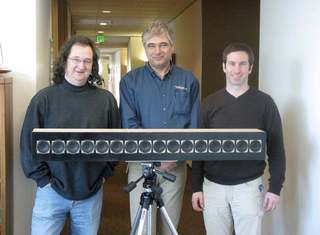
The PNW Section visited Microsoft Research in Redmond WA for its February 27, 2008 meeting on " Using Arrays of Loudspeakers for Focusing or Diffusing Sound." 23 AES members and 41 nonmembers were counted.

(L-R) Jasha Droppo, Ivan Tashev, Mike Seltzer |
Using a "tag team" format, each speaker covered a topic, then a lengthy Q&A was held, door prizes awarded, and finally free time with the research lab demo array hardware devices. Mike Seltzer of the Microsoft Research Speech Technology group started with an overview of reasons for looking into speakers arrays. These arrays were oriented toward home and office use, instead of large reinforcement systems. They could be used to create a more uniform sound field, making every seat a good sounding seat without resorting to headphones. Controlled sound beams could be used in the office to allow a "private" phone call without a headset, or let several listeners hear something different in the home or a retail setup. He noted an existing Yamaha product capable of some of these features; 40 small drivers/2 woofs in a modest, wide cabinet. Next, Jasha Droppo, also of the Microsoft Research Speech Technology group, continued with "Focusing Sound principle and generic beamforming." He went into the basics physics of why the arrays work, comparing the single point source with two point sources interacting, noting how spacing and frequency changes the radiation lobes. A jumble of point sources makes a poor sounding, complex field. He showed sound field simulation with filters to each driver to experiment with beamforming, and steering the the horizontal line array beam by controlling each driver's delay. The theory works fine, but the reality is that each driver isn't the same or ideal. |
Some solutions:
Easy - ignore the problem. Try basic calibration with a microphone analysis system.
Moderate - so a more complex system analysis
Fun - develop new math to solve the problem, which was a segue to the next speaker.
Ivan Tashev, also of the Microsoft Research Speech Technology group, continued with "Robust beamformer design for loudspeaker arrays." He showed several ways of graphing the measured directivity patterns of some real speakers, and some things we might want to do with steerable arrays. We could cover a large area with same sound level (sound reinforcement coverage); focus the sound in a small area, or towards given direction; send multiple sound beams towards different directions; generate a diffuse sound field with no detectable sound source direction. Ivan showed formulas for beamforming, and filter design to focus sound and be as silent as possible elsewhere. When solved for an array, it works fine until real-world drivers are taken into account. It is impractical to do complicated measurement/compensation for each driver in a home system, so a tweaked and maximized formula helps accomodate driver variations/tolerances.
James (JJ) Johnston*, Audio Architect of the Windows Live division at Microsoft finished with "Generating diffuse sound with arrays." He noted that sound only needs to be decorrelated enough to make the ears think it is, fortunately. The main problem here is if we play a diffuse wave through a point source, it is now heavily correlated. Psychoacoustics can solve that if we create a pattern that is diffuse to the ear. In each critical band, scramble the onsets of the signal envelope; the onset is different for adjacent critical bands, and scrambling the frequency response helps. You can also overlay a listening room's acoustics via first arrival from an array speaker, disguising the existing room somewhat. One application possibility is in gaming. The demo apparatus was a horizontal corner array.
45 minutes of Q&A were followed by the awarding of some door prizes, which were won by:
-McCartney and Monterey Pop CDs from Starbucks Hear Music - Sylvia Tashev, Gerard Hranek
-Jellyfish CDs from Steve Turnidge/Ars Divina - Mark Rogers, Rong Hu, Andy Heye
-Panasonic logo ball caps from Northmar, Inc. (a Seattle manufacturers rep) - Tom Monaghan, George Gilman, Ivan Schwartz, Bob Cavanaugh, Veneta Tashev, Steve Macatee
-K+M logo gig bag from Northmar Inc. - Cameron Colpitts
-Wavetek/Meterman items from Fluke/Wavetek/Meterman via Rick Rodriguez - thermometer, Bob Smith; DMM, Janey Wallick; DMM, Rene Jaeger.
-A book, "The Artful Solderer" from Uneeda Audio - Whitsitt Goodson
-Windows Vista software from Microsoft - Aleks Barbour, Scott Holden, Tim Harding
Demo hardware was available the remainder of the evening. These showed:
-Focusing sound - Beam focused towards the array broadside
-Multiple beams - Two beams, one broadside, one under 45 degrees
-Diffuse sound - Stereo sound track, with both direct and diffuse radiation
-and the Yamaha 1100 speaker array for home surround sound
Reported by
Gary Louie, PNW Sectretary
* James (JJ) Johnston is now with DTS Audio, formerly Neural Audio.
Last Modified 06-28-15 23:02:56